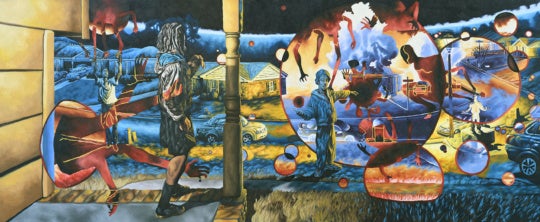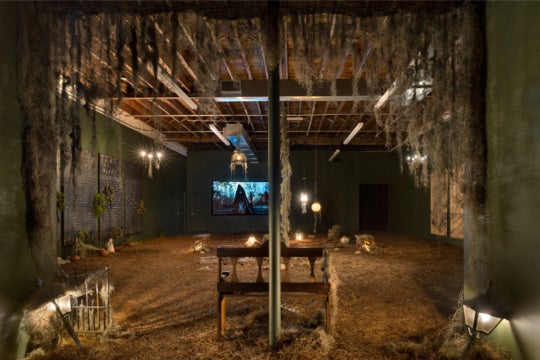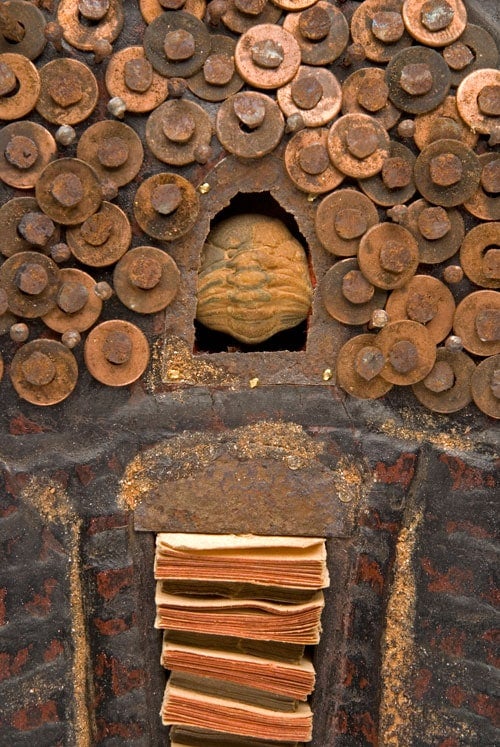
Nearly a half century ago, artist Pablo O’Higgins asked printers Luis and Lea Remba to create a catalogue for his exhibition at the Instituto Nacional de Bellas Artes in Mexico City. He’d been impressed by their high quality output and encouraged them to add a fine art component to their commercial print workshop. So, in 1968, the Rembas, while maintaining their printing business during the day, began making fine art lithographic reproductions at night.
O’Higgins was best known as a founder of the Taller de Gráfica Popular (People’s Graphic Workshop, or TGP), an art collective established in 1937 whose anti-fascist pamphlets, posters, and other printed objects are remembered for provoking socio-political dialogue and for masterful execution.

In 1973, the Rembas took on the task of printing images for Rufino Tamayo, a painter renowned for technical experimentation. Eager to achieve color, depth, and texture beyond the capabilities of lithography, Tamayo presented the Rembas with a formal challenge. Their collaborative response to this challenge birthed the Mixografia workshop and its innovative graphic techniques. This novel wet-print process involves a cast plate mold, typically copper, made from a wax or plastic matrix produced by the artist. Unlike most print processes, the plate is inked with each color that eventually appears in the final work. Moist paper pulp is then applied to the inked plate, and both are run through a press; pressure forms a sheet of a paper that records remarkable surface detail and topography. Meanwhile, akin to a fresco’s wet plaster, the pulp absorbs the ink, resulting in highly saturated colors.
Implied in its title, the exhibition “Paper in Profile: Mixografia and Taller de Gráfica Mexicana,” currently on view at the Georgia Museum of Art, investigates what Mixografia inherited and how it departed from the TGP. With over 130 works by 60 artists – including recognizable names like John Baldessari, Louise Bourgeois, and Ed Ruscha – the exhibition locates the Rembas’ workshop within international postwar and contemporary art, with technique and material at the fore. Exhibited prints and sculptures, all on loan from the workshop, show how Mixografia’s techniques integrate traditional printmaking, painting, and sculpture. Pushing paper’s expressive and rhetorical possibilities and blurring lines between mediums, works on view in “Paper in Profile” thoughtfully complicate conventional boundaries between two and three dimensions.

In his essay, “Profiles in Printmaking: Three Generations of Remba Printers,” which appears in the exhibition’s well-composed catalogue, curator Lynn Boland distinguishes Mixografia from the TGP. Describing how the Rembas resisted restriction to a specific political ideology, he writes, “O’Higgins was anxious to bring the Rembas into the sphere of politics and political art, but, as Luis [Remba] explains, that was not their interest: ‘For me, it was art, not politics.’”
This emphasis on art object over politics is what distinguishes “Paper in Profile” from the Georgia Museum’s 2015 exhibition “El Taller de Gráfica Popular: Vida y Arte,” which amassed over 250 TGP works and focused on the communal atelier’s social and political activities. In our conversation, Boland elaborated this distinction, and told me that the ways the Mixografia workshop followed in the TGP’s wake determined how the two exhibitions took shape.
“In many ways the Mixografia workshop followed on the heels of the TGP, so we could build on the earlier show, looking at similarities and contrasts between the workshops,” said Boland, who is the museum’s curator of European art. “The different emphases of the exhibitions were driven by the philosophies and output of the workshops more than by curatorial design.”
But why two shows on the TGP and Mixografia workshop in Athens, Georgia, in the past two years? Why, at the University of Georgia’s art museum, tell the story of a studio founded in Mexico City and now located in Los Angeles?
“It’s a story that I felt needed to be told,” he replied. “It was a chance to present outstanding works of art by a long list of artists we hadn’t yet had the chance to show. Very few of the artists in the show are represented in our collection.”

As for the question of how the exhibition fits into art at UGA, Boland noted how it complements the interdisciplinary and multimedia focuses of the university’s studio art and printmaking programs.
Still, there are plenty of possible themes with which to gather an impressive list of artists and multimedia objects. Isn’t it meaningful that the museum is putting such effort into showing the importance to contemporary art of a process developed by immigrants? And what of its exhibition catalogue, published in English and in Spanish? Aren’t these socially germane; don’t they make a point?
Boland explained “Most of these decisions were made years ago, so while it was just happenstance, I do think the story of Mixografia offers a timely and concrete example of the ongoing contributions immigrants make in this country.”
No future related exhibitions are planned, but Boland said he wouldn’t be adverse. The Rembas are currently expanding their gallery space in Los Angeles, where Baldessari, Ruscha, and other well-known artists have exhibited in recent years.
Boland capped our talk by stressing the value of seeing the objects in person. A two dimensional representation can only go so far in capturing artworks’ blending of sculptural and printed forms, and their refusal to submit to the picture plane’s confines. He joked that a man on a tour of the show “just absolutely refused to believe that Dario Escobar’s print isn’t a real basketball, to the point of being upset with the docent. When it says ‘paper,’ it really is paper, I promise.”
“Paper in Profile: Mixografia and Taller de Gráfica Mexicana” is on view at the Georgia Museum of Art in Athens through August 21.
Jared Butler is an Atlanta-based critic.




